Improving our service to America’s innovators
Vaishali Udupa, Commissioner for Patents
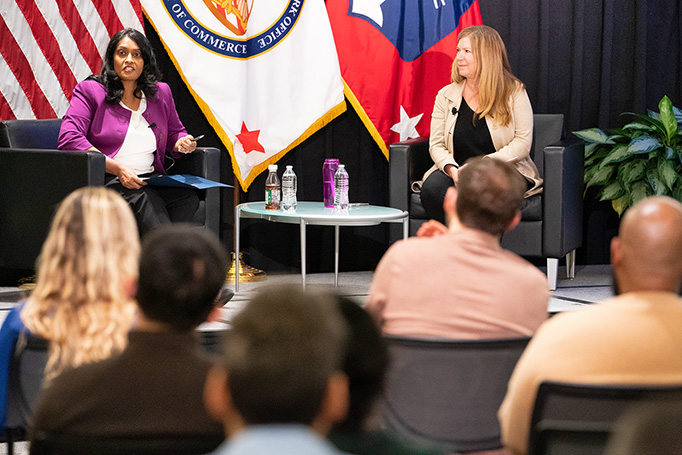
As we announced in September, as part of our modernization efforts to provide more extensible technology and functionality, the EFS-Web and Private Patent Application Information Retrieval (Private PAIR) tools are being retired after their decades of use as electronic filing and application management systems for our Patents customers.
Starting November 15, 2023, the Patent Center system will fully replace EFS-Web and Private PAIR.
Making this transition to Patent Center is essential to ensuring that our tools evolve, that we stay up to date on the latest digital capabilities, and that we continue to deliver excellent customer service to meet your needs.
We are postponing the original transition date (previously November 8) to better respond to and incorporate additional valuable stakeholder feedback into the Patent Center system. Specifically, we are working to increase usability for sponsored accounts with large amounts of customer numbers and address any related issues. We are also ramping up coverage to our Electronic Business Center to respond to questions in real-time and help ensure a smooth transition for our stakeholders.
A one-stop shop for Patents customers
Patent Center pulls all the steps of filing and managing a patent application together into one central system. It offers a next-generation user interface and better overall system performance and security. Patent Center also includes new features to streamline the application process:
- No need to create a new account: you can use the USPTO.gov accounts and sponsorships that you’ve already created for EFS-Web and Private PAIR.
- The ability to upload your patent application specification, claims, abstract, and drawings in a single DOCX document without having to manually separate sections.
- The ability to upload multiple documents at once using the drag and drop interface.
- The ability to download multiple documents at one time in a single PDF or ZIP file.
- The ability to confirm the status of submitted documents and successful payments with separate submission and payment receipts.
- In addition, if you want to get familiar with Patent Center’s features without actually submitting anything, you can explore Training Mode, an interactive simulation to safely practice filing DOCX and PDF documents. You’ll also receive real-time feedback.
Future updates
We’re not stopping here. Since its launch six years ago, we’ve rigorously tested Patent Center and made improvements based on your feedback. We will continue to use your input to enhance the system’s functionality. If you have a suggestion or an idea for new functionality or performance improvement send them to emod@uspto.gov. We review these ideas weekly. Retiring our legacy EFS-Web and Private PAIR systems ensures that we are better protecting confidential application materials and investing patent user fees responsibly. Maintaining these legacy systems during the development and testing of Patent Center made sense to ensure there was no interruption in service. Patent Center is now ready to become the sole system, and it is time to turn off the legacy systems so we can reinvest recovered resources into developing your ideas for new functionality and performance improvements. You can access instructional guides, resources, our on-demand webinar, a list of top 25 questions and answers from previous training sessions, and contact information for technical assistance all on the Patent Center information webpage. Thank you for all the feedback you’ve provided in Patent Center’s six years of operation. We appreciate your continued engagement as we seek to improve our service to you.
Posted at 01:41PM Nov 07, 2023 in ip | Comments[8]
Tips on taking control of your creative IP
Blog by Kathi Vidal, Under Secretary of Commerce for Intellectual Property and Director of the USPTO
 On September 20, Director Vidal spoke with Kim Tignor, executive director of Take Creative Control, about the importance of creators participating in the IP economy. (Photo courtesy of Take Creative Control)
On September 20, Director Vidal spoke with Kim Tignor, executive director of Take Creative Control, about the importance of creators participating in the IP economy. (Photo courtesy of Take Creative Control)
When I first began my tenure as Director in the spring of last year, I pledged to strongly advocate for the value of intellectual property (IP) and its protection. As we work throughout the world to strengthen the IP ecosystem through new laws, policies, practices and collaborations, I consider it an honor to also be an ambassador for IP, impressing upon those with great ideas – including our youth, women across the globe, and our military – the importance of protecting IP.
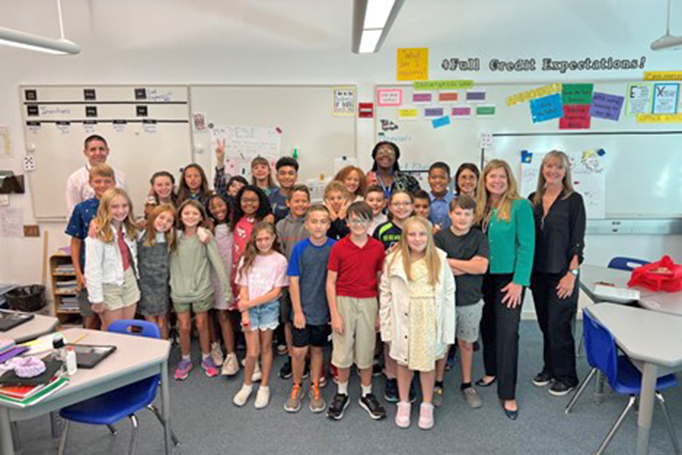
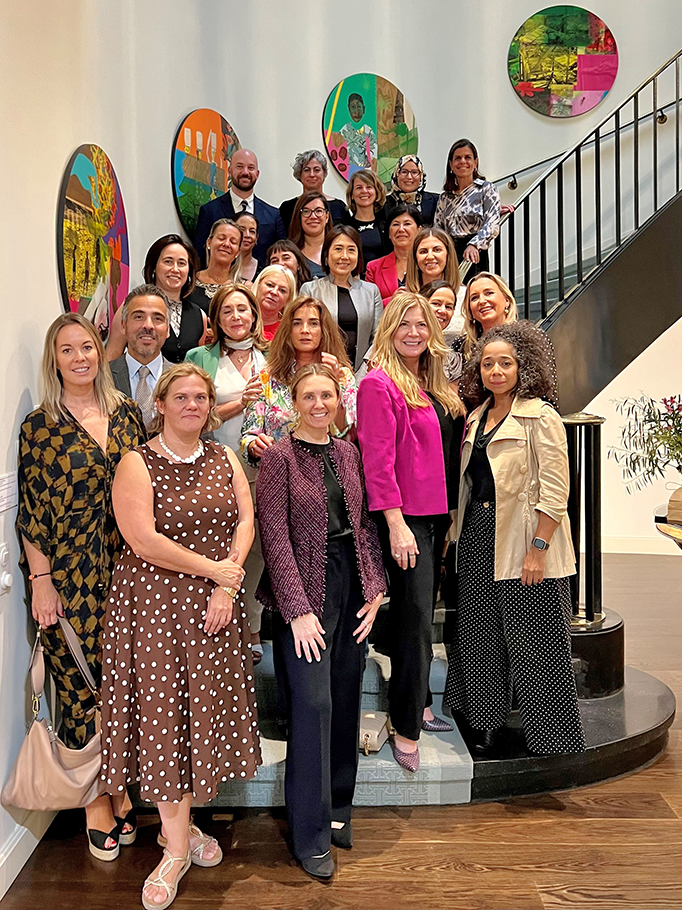 This month, preceding her trilateral meetings with Europe and Japan in Munich, Germany, Director Vidal spoke met with 5th graders on the military base in Rota, Spain and with women entrepreneurs at Ambassador Julissa Reynoso’s residence in Madrid, Spain
This month, preceding her trilateral meetings with Europe and Japan in Munich, Germany, Director Vidal spoke met with 5th graders on the military base in Rota, Spain and with women entrepreneurs at Ambassador Julissa Reynoso’s residence in Madrid, Spain
Patented inventions are in every common device and product you use every day, such as your smartphone, car, or even your hair dryer, brush, and comb. Indeed, the USPTO just granted the 1 millionth design patent for a comb created by Agustina Huckaby, an inventor and licensed cosmetologist from Fort Worth, Texas:
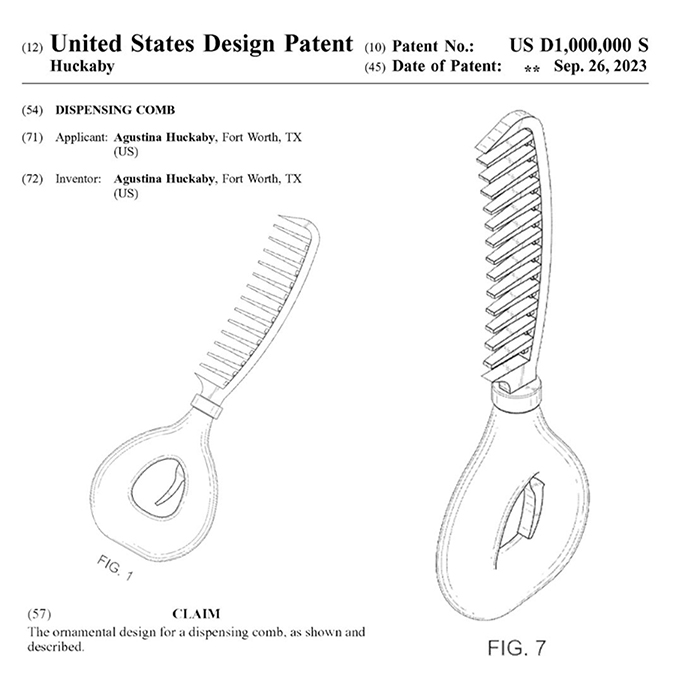
In fact, many products are covered by multiple patents, including for follow-on innovations that improved the product. One example I like to use is Thomas Edison, whose original light bulb that he submitted to the USPTO in the 1800’s is sitting on my desk at our headquarters in Alexandria, Virginia. When I go into classrooms and ask whether Thomas Edison invented the light bulb, the kids know! They say, “No - he just invented a better filament.”
In addition to being able to protect your idea or design with a patent, you can also protect your product, service or company with a trademark. Some widely recognized trademarks are the Nike swoosh; images of the brand names of products including Barbie dolls; Clorox bleach; the unique stitching on the back pocket of Levi’s jeans; and the name and some popular lyrics of musician Taylor Swift. Catchy slogans you come up with for your product or service, such as “If you spray it when you say it no problem” that two 10-year-old girls on a military base in Rota, Spain, came up for their spit-proof headset, can also be trademarked.
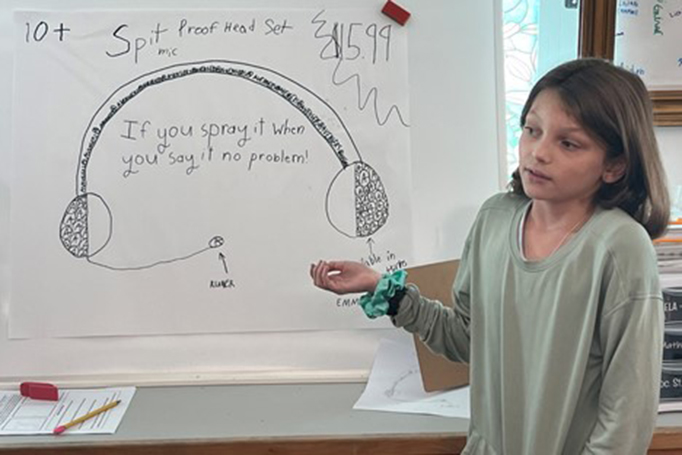 5th graders on the military base in Rota, Spain presenting their “spit-proof headset” to Director Vidal during her visit to the base.
5th graders on the military base in Rota, Spain presenting their “spit-proof headset” to Director Vidal during her visit to the base.
Trademarks can even be scents. Scent marks protect a unique smell from being copied by other similar products.
Play-Doh, for instance, has its scent protected. We recently posted this popular Instagram video asking members of the public if they could identify the unique smell of this scent mark - check out who immediately guessed it.
What about that poem you wrote? Or the picture you took at the school play (or one that turned out so well you may want to sell it online)? Copyrights are there to save the day and to protect you against someone else copying (or to compensate you if they do!). How about that great BBQ sauce that won first prize the state fair and you want to start bottling it and selling it at farmers markets (and maybe later in national stores or online)? Or that drink recipe you concocted? Or perfume? In comes trade secrets. If you take the right steps to ensure nobody has access to your “secret sauce” you may be able to protect your creation just like Coca-Cola did with their famous recipe. Indeed, intellectual property is all around us. Because anyone can be a creator. But people sometimes ask me why they should go through the trouble of protecting their IP. Simple: When you get a patent, trademark, create a work eligible for copyright protection – or protect your trade secret – it’s a valuable asset. You’re investing in yourself and your idea. Our research has found that companies in IP-intensive industries tend to employ more workers, whose average weekly earnings of $1,517 in 2019 were 60% higher than in other industries. Other research shows that protecting one’s IP is crucial to the success of their business. For example, according to a joint study by Harvard Business School and NYU’s Stern School of Business, when used as collateral, a company’s first patent increases venture capital funding by 76% over three years. It can also help serve as an important employee recruiting tool: The approval of a startup’s first patent application increases its employee growth by 36% over the next five years. Further, protecting your IP can also increase your market share – a new company with a patent increases its sales by a cumulative 80% more than companies that do not have a patent. As for trademarks, not only are they important assets, if you end up deciding to launch a business or expand to other areas in the U.S., a federal trademark that you can only get from the USPTO will protect you. You can use your trademark to stop copycat products at the borders or have online resellers remove copycat offerings. You can also use your copyright to have copycat material taken down from the internet. Confused about what type of intellectual property you might need? The USPTO now has an easy-to-use new online tool that lets you figure out what type of IP you have and whether it’s protectable by a patent, copyright, trademark, and/or trade secret. We call it the IP Identifier. It’s a very popular tool among those visitors to our website who are new to IP, with more than 100,000 visits to the page since we launched it earlier this year.
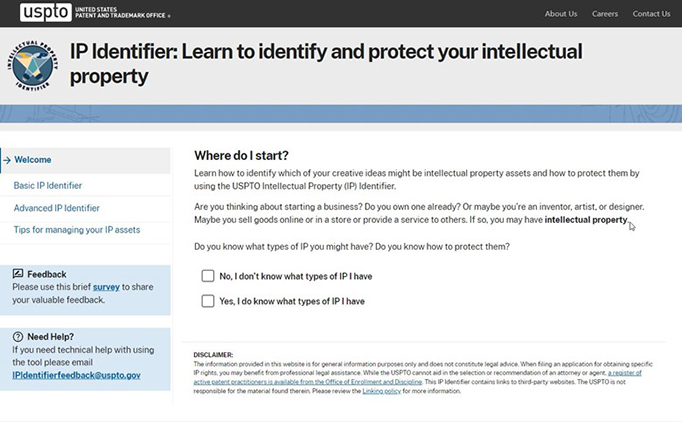
Registering your IP protects your IP – and you. Even during the period when one of our thousands of knowledgeable examiners is reviewing your application, just the submission of your application filing may provide some legal protection in the event someone later tries to claim your idea. And, having a “patent pending” can help you get funding!
Many applicants pursue the help and services of legal counsel. The 84 Patent and Trademark Resource Centers nationwide – often found in academic and community libraries near you – have lists of attorneys they can refer you to, in addition to providing free expert advice on filing and USPTO processes. And for under-resourced inventors, you may be eligible for free legal help filing an application through our Patent Pro Bono program or Law School Clinic program. Check out our information on free legal help.
For more information on USPTO programs, visit our Inclusive Innovation webpage. There are programs for kids, teachers, women, college students, military veterans and spouses, and more.
We hope to see you at a no-cost USPTO program soon!
Posted at 03:05PM Oct 11, 2023 in ip | Comments[2]
Latest updates on artificial intelligence and intellectual property
Blog by Kathi Vidal, Under Secretary of Commerce for Intellectual Property and Director of the USPTO
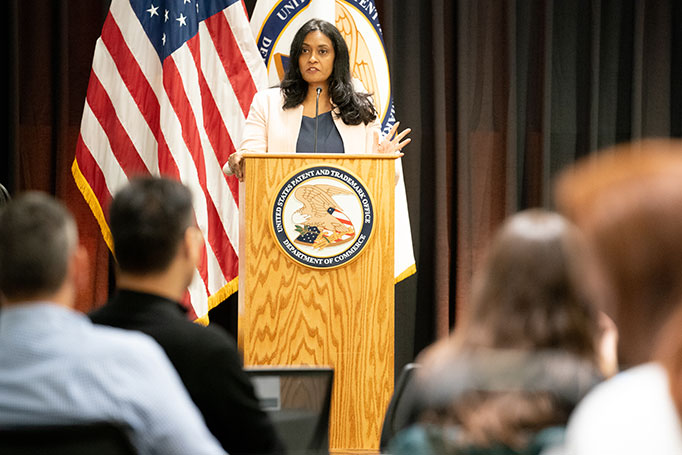 On
September 27, 2023, Commissioner for Patents Vaishali Udupa spoke at the
USPTO’s fourth AI/ET Partnership meeting about the USPTO’s critical role in
advancing emerging technologies and artificial intelligence (Photo by Jay
Premack/USPTO)
On
September 27, 2023, Commissioner for Patents Vaishali Udupa spoke at the
USPTO’s fourth AI/ET Partnership meeting about the USPTO’s critical role in
advancing emerging technologies and artificial intelligence (Photo by Jay
Premack/USPTO)
When it comes to artificial intelligence (AI), there is enormous potential for our country and for solving world problems — but there are significant risks as well. To shape the future of AI, we must act quickly but also thoughtfully and with your input.
Since taking office, President Biden and the entire the Biden-Harris Administration have moved with urgency to seize the tremendous promise and manage the risks posed by AI. The Biden-Harris Administration is currently developing an executive order that will ensure the federal government is doing everything in its power to advance safe, secure and trustworthy AI, and manage its risks to individuals and society. Our Administration will also pursue bipartisan legislation to help America lead the way in responsible innovation. As we advance this agenda at home, the Administration will continue working with allies and partners to establish a strong international framework to govern the development and use of AI worldwide.
The USPTO, and our sister agencies within the Department of Commerce, as well as the U.S. Copyright Office, play a critical role in this work. One of the USPTO’s top priorities is to ensure that the United States maintains its leadership in innovation, especially in emerging technologies (ET) such as AI. Our AI efforts align closely with the Administration’s whole-of-government approach to AI, including the National AI Initiative that seeks to advance U.S. leadership in AI. That is why, under my leadership, the USPTO created the AI/ET Partnership. Over the last year, the USPTO’s AI/ET Partnership has worked closely with the AI/ET community to gather public feedback through a series of meetings on topics related to AI and innovation, biotech, and intellectual property (IP) policy.
In collaboration with you, we have been working to swiftly, but also responsibly, incorporate AI into our work so that we can better serve the American public and increase the robustness and reliability of IP rights. We are integrating AI technologies into our next-generation tools to enhance the quality and efficiency of patent and trademark examination. Our examiners have conducted over 1.3 million searches using AI search tools. These tools also find potential foreign prior art relevant to their examination of a patent application by searching patent documents from over 60 different countries. We are assessing approaches for making these AI search tools publicly available. We are also working to extend search to images for design patents. And, our Trademarks organization is also looking to develop AI capabilities in image searching, classification, and identification of goods which will better assist our more than 750 trademark examining attorneys examining applications for trademark registrations.
We also have several user-facing AI initiatives in development and public beta, to help the public better navigate the patent and trademark systems. The USPTO Virtual Assistant enhances customer service by providing immediate, targeted answers to common questions. While currently available on several Trademark pages; we will be adding the tool to more USPTO pages soon. Our Inventor Search Assistant tool allows you to search for your own prior art to help determine if your invention is patentable (Learn more in this Inventors Digest article). Last year, we held an AI research competition where over 2,300 competitors from over 80 countries created AI models for a patent phrase-to-phrase matching challenge. We offer an AI Patent Dataset that – using a machine-learning (ML) approach that analyzed patent text and citations in patent applications and other documents – identifies patents issued from 1976-2020 with one or more AI technology components, including ML, natural language processing, computer vision, speech, and more.
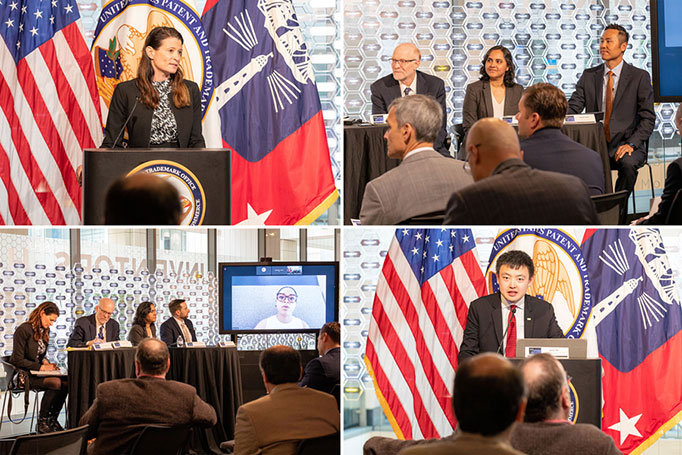 On April
25, 2023, the USPTO held one of several public listening sessions on AI and
inventorship (Photo by Michel Cleveland/USPTO)
On April
25, 2023, the USPTO held one of several public listening sessions on AI and
inventorship (Photo by Michel Cleveland/USPTO)
Our AI/ET Partnership Meeting on September 27 this week explored the many ways that AI is shaping the work of both the USPTO and those who practice before us, along with the role of USPTO data in advancing state-of-the-art AI research and AI throughout the innovation economy. Attendees heard from a distinguished and diverse lineup of AI researchers, IP practitioners, USPTO technologists, and interagency partners. And our economists demonstrated some of our AI data and research initiatives.
Given the
rapid adoption of AI, we are moving swiftly and carefully – including on patent
examiner training. In our report, “Inventing AI: Tracing the
diffusion of artificial intelligence with U.S. patents,” we found that AI is increasingly
important for invention, diffusing broadly across technologies, inventors,
organizations, and geography. For example, recently updated data from our
report indicates that around 80,000 of our utility patent applications in 2020
involved artificial intelligence – over 150% higher than in 2002. AI now
appears in more than 18% of all utility patent applications we receive. Illustrating
AI’s rapid diffusion across fields, patents containing AI appeared in about 9% of all
technologies examined by the USPTO in 1976, and spread to more than 50% by
2020. And, this data precedes what we have all seen in the past six
months.
For many years, we have offered AI related training through our Patent Examiner Technical Training Program (PETTP) and Site Experience Education Program. In fiscal year 2023, through PETTP, we held over 200 AI training courses, which were viewed over 8,000 times by our examiners. These programs keep patent examiners up to date on the latest technological developments, emerging trends, and recent innovations, including in AI. Examiners hear from and engage directly with scientists, engineers, and other experts from universities and innovative organizations, to learn the latest on the various technologies examined throughout the USPTO. Additionally, through a new partnership with Carnegie Mellon University, we are rolling out a 21-course curriculum over the next few months on AI for patent examiners tailored to their own needs. And we will soon launch a new Premier Lecture Series, bringing AI experts to share their insights with USPTO personnel to help strengthen our examination process. If you have expertise in AI, reach out to us at aipartnership@uspto.gov!
As for our other critical work, we are working to assess how our stakeholders’ use of AI impacts the work we do and, after hearing from you on inventorship, we are working to provide clarity on inventorship for AI-assisted inventions, to be followed by working with you on obviousness and other key areas of IP law that need attention in view of AI.
As we work on our own AI efforts and outreach, we coordinate closely with other agencies on their efforts, such as the U.S. Copyright Office (USCO), who recently issued at notice of inquiry (NOI) on copyright and AI. As the Administration's IP advisor and close partner with the USCO, the USPTO is looking forward to working with the USCO on these important issues as they gather public input and feedback related to AI and copyright. Initial written comments are due by 11:59 p.m. Eastern Time on October 30, 2023. Reply comments are due by 11:59 p.m. eastern time on November 29, 2023. Your feedback to the NOI is critical. We will use your feedback and the USCO’s findings to advise the Administration on policy around copyright and AI.
In addition, the National Institute of Standards and Technology (NIST) recently published a request for information seeking public input on how best to implement the U.S. Government National Standards Strategy for Critical and Emerging Technology. And, we published a parallel request for comment alongside NIST and the International Trade Administration (ITA) focusing on the intersection of those standards and IP. From AI to quantum technologies, NIST, ITA and the USPTO have been collaborating very closely at the intersection of standards, innovation and IP. The response dates for both requests is November 6, 2023.
Stay tuned as there is more on AI to come! For any questions or feedback on our AI efforts, or to suggest a topic for a future meeting, please contact aipartnership@uspto.gov.
Posted at 09:17AM Sep 29, 2023 in ip | Comments[4]
USPTO’s Trademark Public Advisory Committee: Where we’ve been and where we’re headed
Guest blog by David Cho, current chair of the USPTO’s Trademark Public Advisory Committee (TPAC) and Assistant Vice President Senior Legal Counsel, Trademarks & Copyrights of AT&T Services, Inc., and Susan Natland, immediate past chair of TPAC and co-chair of Knobbe Martens Trademark and Brand Protection Group
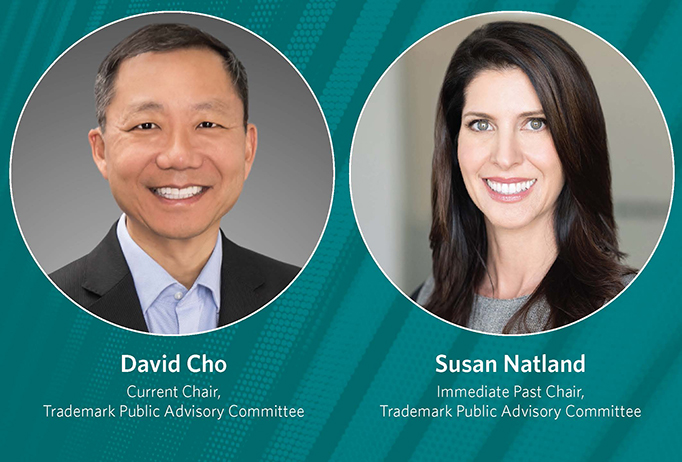
So, what are the key takeaways in the world of TPAC from 2022 and what can we expect in 2023?
Reduction in time to first examination: The USPTO has seen record trademark filings in recent years, creating a massive “inventory” of trademark applications waiting to be examined. In 2022, the time from the filing of a trademark application to its first substantive review by the USPTO – also known as “first action pendency” – rose to an average of more than eight months. To put this in context, first action pendency in 2019 and 2020 was between three and four months. By the start of 2021, the flood of new applications started driving up first action pendency. In support of the Trademark Office leadership, TPAC members provided valuable analysis and feedback as the USPTO implemented initiatives to meaningfully reduce pendency. These include measures such as hiring and training new examining attorneys and other personnel, streamlining workflows, changing procedures, as well as deploying IT solutions to increase examination efficiency. These efforts are continuing in 2023 with ongoing TPAC advice.
Addressing trademark scams and fraud on the USPTO: In 2022, TPAC provided timely advice to the USPTO as they continued to address the increasing issue of fraud on the USPTO, which affects the integrity of the trademark register and causes ripple effects across the trademark community. TPAC strongly supported the USPTO’s ongoing efforts to crack down on fraud in 2022, including: (i) alerting users to known scammers by posting a list of scammers on the USPTO website; (ii) working with law enforcement where appropriate and sanctioning filers that violate USPTO rules; (iii) securing federal registration of the USPTO’s own trademarks to assist in stopping USPTO impersonators; and (iv) implementing a new system requiring all trademark filers to verify their identities as a condition for filing electronic trademark forms. We expect to see continued and additional efforts in these areas in 2023.
Advancing equity across the brand community: In 2022, TPAC’s Diversity, Equity, Inclusion and Accessibility (DEIA) Task Force provided valuable guidance on and support for USPTO initiatives related to diversity and inclusion both within and outside the agency. TPAC’s commitment to focusing on increasing access and opportunities for all those with dreams of entrepreneurship led to elevating this task force to a subcommittee called Innovative Inclusion.
Combatting counterfeits: TPAC also strongly supported Director Vidal and the USPTO’s efforts to combat counterfeiting. In 2022, TPAC provided Director Vidal with ideas to address this scourge—some more traditional, such as increased and updated consumer (i.e., “buyer side”) education, and some more “outside the box.” TPAC believes that Director Vidal and the USPTO have done a great job articulating and providing visibility into the harm counterfeits bring to the U.S. economy, brand owners, consumers and communities. Keep an eye out for additional work in 2023 in this area as TPAC continues to provide input through a sub group experienced in fighting counterfeiting.
Highlighting the value of trademarks: A key part of TPAC’s focus is championing the value that trademarks bring to the U.S. economy. The USPTO’s March 2022 report on IP and the U.S. economy showed the enormous role that trademarks add to the financial health of U.S. IP-intensive industries, which accounted for $7.8 trillion in U.S. annual GDP. Of that total, $6.9 trillion—about one third of the entire U.S. GDP—comes from trademark-intensive industries. In addition, the report found that trademark-intensive industries supported more than 56 million U.S. jobs. The more we highlight the value of trademarks, the more the U.S. economy grows, consumers are protected, and creativity and innovation flourish.
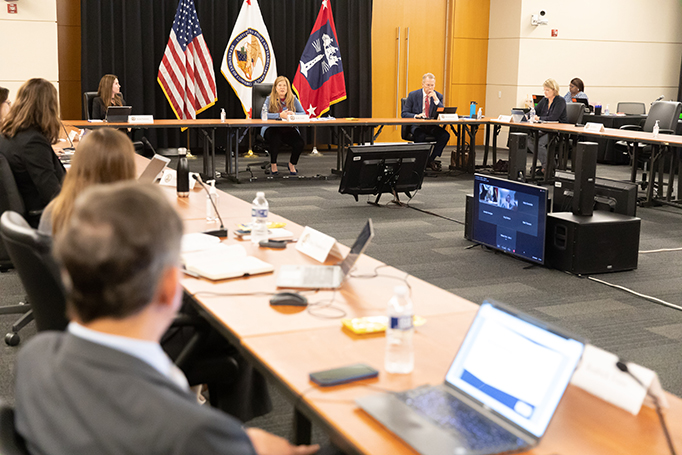
One way to highlight the value of trademarks it to honor them, and we look forward to further opportunities in 2023 and beyond to celebrate these critical legal protections that propel commerce and the U.S. economy. We also encourage you to check out USPTO’s Journeys of Innovation series which shares the stories of inspiring entrepreneurs whose trademarks serve as a critical way to communicate with their customers. These real-life stories truly exemplify the power of trademarks.
We have touched on a few highlights here, but this is just the tip of the iceberg! We encourage the trademark community to get involved in TPAC (more information can be found on the TPAC page of the USPTO website), to attend a TPAC public meeting, and to read more about the important work of our committee in our 2022 TPAC Annual Report.
Note: The current 2023 TPAC voting members are: David J. Cho (Chair), Adraea Brown (Vice Chair), Jomarie Fredericks, Tracy Deutmeyer, Dana Brown Northcott, Rodrick Enns, Deborah Gerhardt, Donna Griffiths, and Amy Hsiao. Each person is appointed by the Secretary of Commerce to serve on TPAC for a three-year term. For more information about the TPAC, its members and its work, visit the TPAC page of the USPTO website.
Posted at 08:33AM Feb 02, 2023 in USPTO | Comments[7]
Patent Public Search tool – a streamlined way to search all U.S. published patent applications
Blog by Andrew Faile, Acting Commissioner for Patents, and Jamie Holcombe, Chief Information Officer
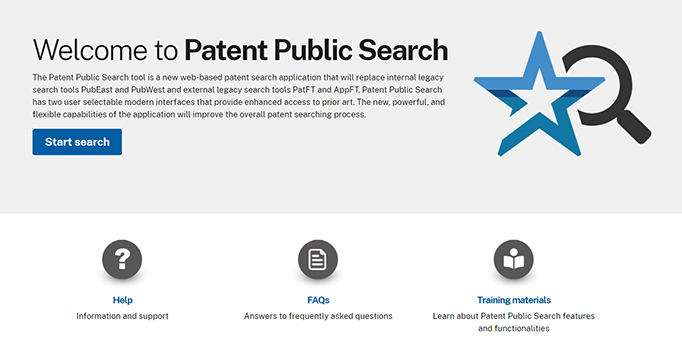
“The work you have done on the new public search system is top notch… it saves a lot of time while improving the search results I am able to obtain… Very impressive work.”
“Looking forward to using this new tool for my upcoming patent applications.”
As part of our ongoing effort to modernize and streamline our systems, earlier this year, we unveiled an all new Patent Public Search (PPUBS) tool. PPUBS is a free online search tool for all U.S. published patent applications and patent grants. Currently, approximately 4,500 users are conducting patent searches with PPUBS each day in the U.S. and internationally, and close to 350,000 people have used PPUBS since it launched. Based on the success and positive feedback we’ve received on PPUBS – with a few testimonial examples listed above – it will officially replace our legacy systems this September.
With the launch of PPUBS, you can now search the text of all published U.S. patents and U.S. Pre-Grant publications (PGPubs) remotely in one streamlined system. Previously, in order to conduct a similar search, you needed to visit a USPTO facility like our headquarters in Alexandria, a regional office, or a Patent and Trademark Resource Center. That also meant using one of four legacy systems: Public-Examiner’s Automated Search Tool (PubEAST), Public-Web-based Examiner’s Search Tool (PubWEST), Patent Full-Text and Image Database (PatFT), and Patent Application Full-Text and Image Database (AppFT).
We developed PPUBS based on the current internal tool used by patent examiners, Patents End to End Search (PE2E-Search). Some similar features include highlighting, efficient tagging, and advanced notes for searching, analyzing, and managing patent data.
Some additional benefits of PPUBS include:
• Layouts: Multiple layouts and tools allow you to view more data at once and perform more precise searching.
• Highlighting: Multi-color highlighting allows you to easily sort and categorize your search results.
• Tagging: Document tagging allows you to group, rename, or color code your search results, helping you better organize your data.
• Notes: More advanced notes allow you to include tags, relevant claims, or other useful details.
• Quality: Robust full-text searching of U.S. patents and published applications improves the quality of your search and provides enhanced access to prior art.
• Familiar usability: If you previously used PubEAST and PubWEST, you will find that PPUBS has similar familiar searching options.
We are holding a number of regular training sessions on PPUBS – including webinars for novice searchers and advanced searchers. To view upcoming public training sessions, visit the events page of the USPTO website. We also offer training materials, quick reference guides, frequently asked questions, and a help center on the Patent Public Search webpage.
Your feedback is important to help us identify any issues with PPUBS and to determine features we may want to add or improve. If you have questions about Patent Public Search, please contact us. We are confident the new, powerful, and flexible capabilities of PPUBS will improve the overall patent searching process. If you aren’t already using it, we hope you’ll try it soon!
Posted at 08:22AM Aug 10, 2022 in patents | Comments[12]
Modernizing the management of patent applications with Patent Center
Blog by Kathi Vidal, Under Secretary of Commerce for Intellectual Property and Director of the USPTO
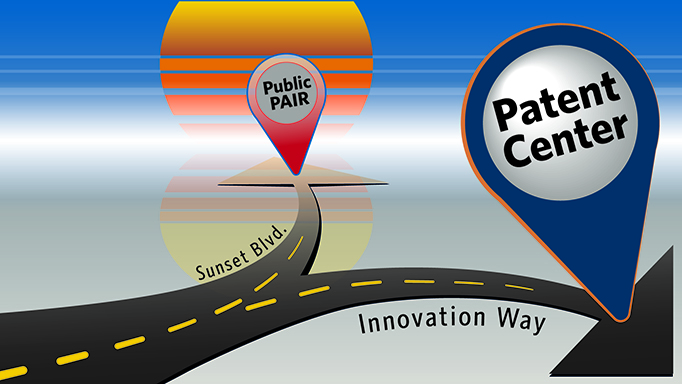
Patent Center provides independent inventors, registered patent attorneys and agents, and other patent professionals with real-time status information, application documents, and transaction history for pending patent applications.
If you are a Public PAIR user who is new to Patent Center, you will recognize many of the same features. For example, Patent Center still provides capabilities to access publicly available patent documents as a guest by application, patent, Patent Cooperation Treaty (PCT), publication, and/or international design registration numbers. Users are also able to sort documents and transaction history based on column headings.
Patent Center also offers improvements that will simplify how you file and manage your patent applications. Those improvements include:
1. Streamlined accounts in a single interface: Allows you to use existing USPTO.gov accounts from EFS-Web and Private PAIR in a single streamlined interface.
2. Increased uploading and downloading options: Using the drag and drop interface, you can upload multiple files at once. We’ve also added new options to download patent references, documents in DOCX and XML formats, and bibliographic information in XML format.
3. Simplified document submissions: You can submit the specification, claims, abstract, and drawings in a single DOCX document without having to manually separate sections.
4. Clear submission and payment receipts: By separately providing submission and payment receipts, you will be able to separately track the status of submitted documents and successful payments.
5. Integrated sponsorship management: Allows you to switch between sponsors without signing on and off.
These are just a few of the benefits Patent Center offers. To help familiarize you with Patent Center, we are hosting frequent training sessions which include opportunities to ask detailed questions. The Patent Center page of the USPTO website also has information on the latest releases and upcoming features. There, you’ll find a thorough Patent Center user guide and list of Patent Center frequently asked questions. Using the interactive simulations in Patent Center training mode, you can also safely practice filing DOCX and PDF documents without saving or submitting to USPTO systems.
Since its launch in 2017, Patent Center has been rigorously user-tested, and we have made many improvements based on public feedback, but we are never done listening. We welcome further feedback on Patent Center functionality by email at emod@uspto.gov and through our Ideascale page.
For other Patent Center questions, technical assistance, or troubleshooting, please contact the Patent Electronic Business Center (EBC) from 6 a.m. to midnight ET, Monday through Friday, by phone at 866-217-9197, or by email at ebc@uspto.gov.
Posted at 05:41AM Jul 12, 2022 in patents | Comments[5]
Safeguarding the trademark community against fraud with identity verification
Blog by Kathi Vidal, Under Secretary of Commerce for Intellectual Property and Director of the USPTO, and David Gooder, Commissioner for Trademarks at the USPTO

Trademark Terminal. Trademark Regal. Trademark Falcon.
Most folks in the trademark community know these names and the havoc they’ve wreaked on legitimate filers, scamming some out of tens of thousands of dollars or hijacking identities to file fraudulent submissions to disadvantage competitors. Their unscrupulous business operations are among the primary reasons why, starting August 6, 2022, the USPTO is taking the important and necessary step of requiring all trademark filers to verify their identities as a condition for filing electronic trademark forms. This initiative, which includes options for both paper and automated identification verification, is key to our comprehensive strategy to protect our trademark customers and the integrity of our trademark register.
Initially a voluntary option, our identity verification program started in January 2022 to better serve our legitimate customers and help prevent bad actors from violating our USPTO Rules of Practice and website terms of use. Since 2016, we have seen significant increases in fraudulent trademark filings, as well as in the number of foreign scammers from China, Pakistan, and elsewhere outside the U.S. These scammers fraudulently file improper submissions that include false signatures, false addresses, false claims of use required to obtain and maintain a registration, and false or hijacked U.S. attorney credentials. In fact, in the past seven months alone, the USPTO has sanctioned bad actors responsible for nearly 20,000 invalidly filed applications.
During the voluntary period, we received thoughtful feedback and suggestions from stakeholders on ways to improve our automated verification process. We listened, and we have updated our original program to include more options and features for trademark filers—both online and by paper. These options include an online program where, after a customer’s identity is verified through the matching of an uploaded selfie and a copy of their government-issued ID (1:1 matching), the selfie is automatically deleted from the system after 24 hours. Further, if a customer does not want to use the automated 1:1 facial matching option, they can verify their identity via a brief video interview with an online representative. The video will be deleted within thirty days of the interview. We are also continuing to offer the paper process for verification. Filers who already have ID verified USPTO.gov accounts for their patent submissions can use their existing accounts for trademark filings as well.
We believe in customer choice and in tools that are equitable and secure. We are gratified that more than 58,000 trademark filers have already chosen to verify their identities through this program. We will continue to listen and learn from all those who believe in preserving an effective and secure trademark register and want to work with us to protect our trademark community. Further, we will soon be issuing a Federal Register Notice that provides additional clarity and context on the user roles required to verify filers’ identities and help maintain a seamless verification process. We welcome stakeholders to visit our ID verification program page to learn more about our program.
It is our privilege to serve our nation’s trademark community, and it is a privilege we do not take lightly. As we continue to develop our Register Protection program to get ahead of the problem, we will also continue to do everything in our power to thwart those looking to scam our customers. That includes issuing sanctions orders and listing known bad actors on our website. We also support our trademark customers and those seeking to protect their brands by providing more information on our processes and resources through programs like our Trademark Basics Boot Camp series and in our new Trademark Registration Toolkit. And, of course, by working every day for American business owners.
Posted at 06:05AM Jun 30, 2022 in trademarks | Comments[2]
Celebrating LGBTQ+ Inventors and Entrepreneurs
Joint blog by the U.S. Patent and Trademark Office (USPTO) and the Economic Development Administration (EDA)
This month, the U.S. Department of Commerce is celebrating the LGBTQ+ community and paying tribute to the many LGBTQ+ entrepreneurs and innovators who help fulfill the promise of America for all. Below we share the stories of a few leaders in the community and ways in which our agencies are advancing inclusive innovation for the betterment of society.
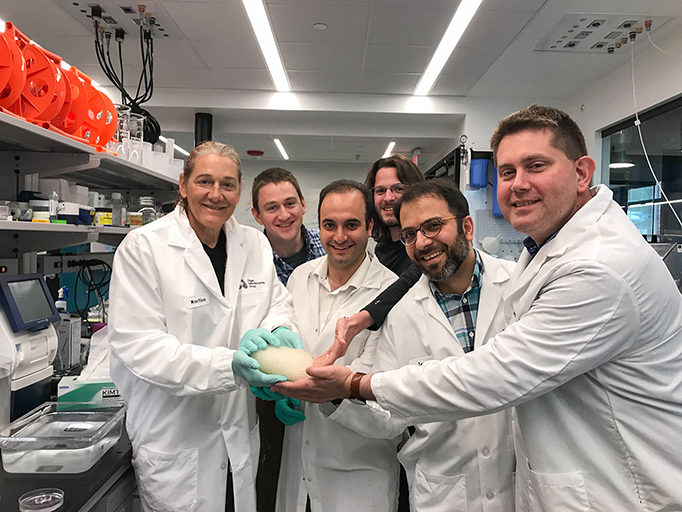
Dr. Martine Rothblatt is an entrepreneur, innovator, lawyer, author, movie producer, and social activist. Faced with daunting challenges throughout her life, Rothblatt learned to push past the idea of the insurmountable. Her long list of accomplishments includes creating and commercializing satellite radio, founding a biotechnology company that seeks to provide an unlimited supply of transplantable organs, setting world records for electric flight, becoming a leading advocate for transgender rights, and delving deep into the future of artificial intelligence (AI) with her work on digital immortality. Rothblatt holds over 80 patents. Learn more in “Persistence is omnipotent,” the USPTO’s Journeys of Innovation story about Rothblatt.

Scientist Natalia Bilenko develops AI tools that are transparent and usable for anyone. An accomplished inventor, she was named on five patents by age 37. At medical device company Caption Health, she works on employing AI to make ultrasound scanners easier to use. The company’s cutting-edge AI-guided scanner was named one of the “100 Best Inventions of 2021” by Time Magazine. The technology is designed to catch heart problems early and could be particularly helpful for people who live in rural areas far away from experienced cardiologists and ultrasound technicians. Bilenko, whose interests extend to the intersection of AI and art, co-created the world's first interactive exhibit to use real-time brain activity, called Cognitive Technologies, for the San Francisco Exploratorium. As a visible role model in the AI community and an organizer of Queer in AI, Bilenko works to ensure the field welcomes ideas and perspectives from all scientists. Learn more in the USPTO’s Journeys of Innovation story on Bilenko, “Artificial intelligence for all.”
The Department of Commerce not only celebrates these entrepreneurs, but also works to support others like them. The USPTO holds a number of events that help advance equity in innovation, including this month’s popular Proud in Innovation series, and has launched new resources such as our inclusive innovation page. These programs and events inspire and encourage inventors and entrepreneurs from all backgrounds to develop their ideas and seek intellectual property protection for them to help enact real change and improve our world.
Working with Thrive West Central, the EDA recently capitalized a Revolving Loan Fund (RLF) that will provide critical gap financing to LGBTQ+ and other minority-owned small businesses. Among its initiatives, the Intentional Outreach Network undertakes dedicated outreach to the LGBTQ+ community to empower, guide, promote, enhance, connect, and grow LGBTQ+ business leaders and entrepreneurs. Prospective borrowers from underserved populations — including the LGBTQ+ community — or those that commit to employing individuals from these communities, will be prioritized for loans.
Expanding opportunity and creating an economy that works for all Americans is central to the Department of Commerce’s mission and strategic plan. The Economic and Development Administration and the U.S. Patent and Trademark Office are proud to join all Commerce bureaus in celebrating the LGBTQ+ community and recognizing their significant contributions to our nation’s economy, competitiveness, and growth.
Please visit USPTO’s inventor and entrepreneur resources page to learn more about protecting intellectual property. Additional information about EDA’s Revolving Loan Fund (RLF) program is available at its website.
Posted at 04:44AM Jun 27, 2022 in USPTO | Comments[1]
Artificial intelligence tools at the USPTO
Blog by Drew Hirshfeld, performing the functions and duties of the Under Secretary of Commerce for Intellectual Property and Director of the USPTO

To incorporate AI into our examination tools and processes at the USPTO, we’ve undertaken a comprehensive development strategy including extensive market research and rigorous testing of a wide range of proof-of-concepts to identify the best solutions. Our objective is not just to deploy smarter technology, but to build a smarter organization by coupling the strengths of our workforce with the strengths of AI. This is the beginning of a whole new trajectory in how we leverage technology to transform patent and trademark operations for the better.
We are incorporating AI tools into two critical areas of patent examination: search and classification.
Performing a complete prior art search is a critically important component of the patent examination process and the USPTO’s mission to issue reliable patent rights. However, the exponential growth of prior art and tremendous pace of technological innovation make it increasingly more difficult to quickly discover the most relevant prior art. To meet this challenge, we have developed an AI-based prototype search system that helps to identify relevant documents and provides suggestions for additional areas to search. In addition to providing world-class patent AI models, the system is designed to learn from the world’s greatest patent searchers, our USPTO examiners. The system is configured to automatically capture feedback data from our examiners to yield additional enhancements over time. We are also developing features to help examiners interpret results generated by the AI models to provide transparency into the system. A beta version of this new AI tool was released to a subset of examiners in March 2020. Assessments conducted to date yielded promising results, and steps are being taken to incorporate AI into our next generation search tool for examiners.
We also developed an auto-classification tool that leverages machine learning to classify patent documents using the Cooperative Patent Classification (CPC) system. The system can suggest CPC symbols, and includes the ability to identify claimed subject matter for additional refinement of the suggested CPC symbols similar to our AI search system. The auto-classification system also includes indicators that provide users with insight into the reasoning of the AI, by linking suggested CPC symbols to specific portions of the document. Enhanced feedback mechanisms designed into the system integrate with our existing classification processes to support training the AI. Based on an analysis of system performance, the USPTO implemented auto-classification in December 2020 to automatically identify claimed subject matter with CPC for internal operations. As a result, the agency is realizing reductions in procurement expenditures for acquiring CPC data. Additionally, we are continuing to develop further capabilities to support a broader range of patent classification requirements at the USPTO.
These successes are demonstrating the value of applying AI to improve the agency operations and strengthen the IP system. To continue building from these successes, our Patents team has expanded their investigations to explore potential new opportunities to leverage AI. For example, research is now underway on AI-based image search capabilities which could open up whole new ways to retrieve prior art. This could be particularly useful for searching patent applications where examiners rely heavily on images for making patentability determinations, such as design patent applications.
On the Trademarks side, we recently completed market research in AI capabilities for image comparison and for checking the acceptability of identification of goods and services against the entries in the Trademarks ID Manual. The USPTO team developed AI prototypes to compare trademark images, to suggest the correct assignment of mark image design codes, and to determine the potential acceptability of the identifications of goods and services. A beta test of these prototypes through a common user interface with approximately 10 stakeholders began in November 2020 and continues, with a larger beta possible later this year. In addition, the USPTO has tested solutions for false specimen detection capabilities using a software program, which was integrated on December 1, 2020 into the agency’s efforts to identify digitally manipulated specimens of use or mock-ups of web pages. Finally, a prototype of an AI based chatbot for answering frequently asked questions via the USPTO website could be ready for beta testing later this year.
Overall we have achieved some remarkable milestones and made great strides toward integrating AI into the USPTO’s day-to-day functions. Stay tuned for more exciting updates from the USPTO on AI in the near future.
Posted at 06:12AM Mar 18, 2021 in USPTO | Comments[7]
The growing importance of international cooperation to the protection of industrial designs
Blog by Drew Hirshfeld, performing the functions and duties of the Under Secretary of Commerce for Intellectual Property and Director of the USPTO, and Mary Critharis, Chief Policy Officer and Director of International Affairs of the USPTO
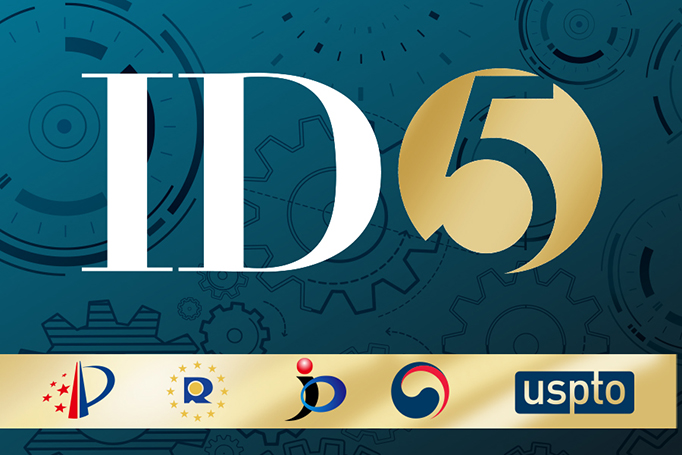
Today industrial design helps turn complex technologies into products that can be used by billions of people, surmounting massive differences in language and culture. But with industrial design’s growing complexity, its exponential growth in importance in our time, and the advent of new technologies—such as personal computing and the numerous digital devices on the market today—it is important to ensure that our systems for protecting designs are meeting the needs of global designers.
In response to these challenges, the world’s five largest industrial design offices—the China National Intellectual Property Administration, European Union Intellectual Property Office, Japan Patent Office (JPO), Korean Intellectual Property Office (KIPO), and the United States Patent and Trademark Office (USPTO)—came together in 2015 to create the Industrial Design 5 Forum, or ID5. Their goal was straightforward: the five offices pledged to “promote and further the development of user-friendly, highly efficient and interoperable industrial design protection systems.”
The ID5 celebrated its fifth anniversary in October 2020 at the annual meeting hosted by the United States (and the forum’s first-ever virtual meeting). Meeting virtually may have been driven by necessity, but it highlighted the forum’s versatility and provided representatives from the five intellectual property offices with the opportunity to take stock of the impressive progress they have made since 2015 and to map a way forward for future cooperation.
Those accomplishments include:
- Implementation of the World Intellectual Property Organization (WIPO) Digital Access Service for designs. This electronic document exchange system has made the process of seeking design protection in multiple jurisdictions around the world significantly more efficient, and has resulted in substantial cost savings for patent applicants. (And, given the challenges presented by the pandemic in obtaining certified paper copies of applications, has eliminated countless problems and headaches for applicants across the globe.)
- Agreement by the JPO, KIPO, and USPTO on a set of common recommended design formalities practices. This agreement is in line with the draft Design Law Treaty that is currently still pending at WIPO.
- Completion of 16 projects and comparative studies providing patent applicants with numerous new comparative reference manuals to help them more easily navigate the global design patent system. Key topics include eligibility, grace period, partial designs, and 3D printing.
For U.S. patent holders and applicants, these accomplishments mean simplified electronic procedures for design patent filings abroad, and the availability of a set of tools to help them understand the practices and procedures of the five partner offices where international protection is most often sought.
Over the coming years, it will be essential for the USPTO and its international partners to work together through forums such as the ID5 to anticipate and address the challenges that still exist in the global design system for applicants. The ID5 partners recognized this at their October meeting by undertaking a number of new projects, including studies on term and renewal of protection and deferred publication and examination. They also made plans to engage in further discussions regarding the use of new technologies in examining and issuing industrial design rights.
In addition, the ID5 partner offices underlined the importance of soliciting stakeholder input in the forum’s deliberations by unveiling a joint communication plan that will allow for improved engagement with stakeholders.
Finally, recognizing the important role of intellectual property offices in the current climate, the offices pledged in a special joint statement on COVID-19 that they “stand united in their efforts to respond to the pandemic and to continue to strengthen the international intellectual property system.”
More than ever, industrial designs are being used around the world to create intuitive interfaces that turn complex technologies into useful tools. Facilitating their development and protection within a workable, international framework will be important to meeting the needs of the international design community. The USPTO is hard at work with its ID5 partners to meet this collective challenge, and is actively engaged with U.S. stakeholders, through such means as a recent forum on global trends in industrial design, to ensure that the latest developments in international design protection are made widely known. To learn more, visit the ID5 website.
Posted at 03:16AM Mar 01, 2021 in ip | Comments[1]

